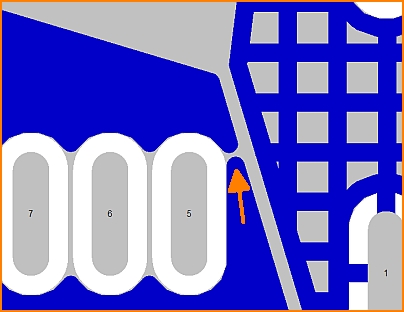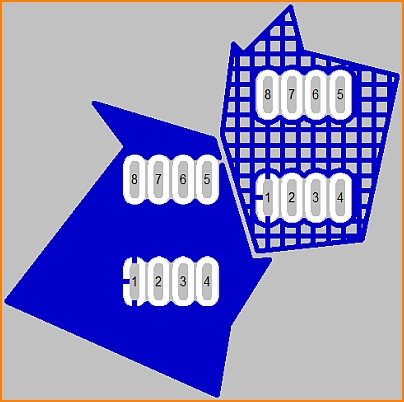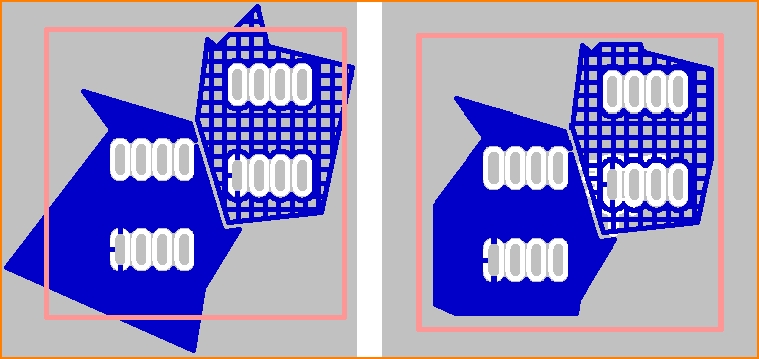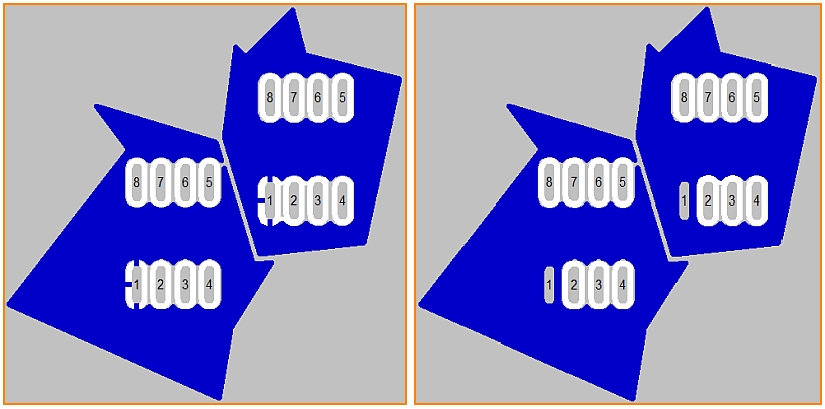« Polygone de signal » : différence entre les versions
Aucun résumé des modifications |
Aucun résumé des modifications |
||
| Ligne 2 : | Ligne 2 : | ||
L'icône se trouve parmi les fonctions de dessin.<br> | L'icône se trouve parmi les fonctions de dessin.<br> | ||
== General == | |||
Tout polygone rempli sur une couche de cuivre peut être muni d'un signal. Il peut être manipulé comme un plan de masse séparé. Il peut être fourni individuellement avec des attributs. Sur une couche de cuivre, plusieurs polygones avec des signaux différents peuvent être dessinés.<br> | |||
Vous pouvez accéder à ce mode:<br> | |||
*par touche de clavier [6], | |||
*par élément du menu "6 Dessiner un polygone de masse" dans menu "Éléments" | |||
*par l'icône [[Image:PolySignal.jpg]] entre des fonctions de dessin [[Image:Pen.jpg]] | |||
<br><br><br> | |||
== What you can do == | |||
Define the corners of the polygon by [[Conventions|'''M1''']]. You can close the polygon automatically by '''[Return]''' when drawing the last segment. [[Conventions|'''M2''']] does the same so that you end the line exactly on the starting point. Immediately the dialog for edition of the signal polygon opens.<br><br> | |||
[[image:massepolygondDLG_e.jpg|Dialog for signal polygon edition]]<br>The dialog for signal polygon edition<br><br> | |||
<b>Layer:</b> a polygon with signal assignment can only be created on a copper layer. The copper layers used in your project can be selected from the drop down list. Select the copper layer upon which your polygon later shall appear (copper bottom, copper top, copper inside). <br><br> | |||
<b>Signal:</b> Select the signal to be assigned to the polygon. At this point you can only assign one signal to one polygon. Creating a [[Star shaped ground]] is a separate topic. Please have a look there.<br><br> | |||
<b>Track width:</b> In easy words track width is the thickness of the pen which you use to fill the polygon with color. Sounds a bit childish but in respect to the production technique it is the best way to compare. In Gerber a photo pen follows the lines on a photosensitive board with an aperture according to the track width. The sharper the tip of the pen, the more filigree structures can be built. Discuss the smallest value with your PCB-house. Here in Europe the minimum value of 0.15 mm is common.<br><br> | |||
The following picture shows the polygon with a little notch see arrow. The reason is a track width set too wide. The pen can not go through this bottle neck.<br><br> | |||
[[image:signalpolygone_gap.jpg|Track width too big]]<br>Track width too big to close the area at this spot.<br><br> | |||
Referring to the track width set here the DesignRuleCheck later checks whether the minimum track width od a connection is fulfilled. The track width must also be seen in combination with the "Grid spacing". A gridded ground plane in consists of a net-structure made of orthogonal intersecting lines. The width of this lines you also define here. You can only enter one value for the track width here. The net structure (= ground plane in lines) always has a square mesh structure.<br><br> | |||
<b>Grid spacing:</b> A ground plane in lines offers production advantages in galvanization and also is preferable in respect to electromegnetic performance of the signal. In addition to the track width you can define the distance of the mesh.<br><br> | |||
[[image:signalpolygone_grid.jpg|Ground plane in lines]]<br>Copper top: Ground plane in lines (to the right). Track width: 0.3mm, Grid spacing: 0.5mm<br><br> | |||
<b>PCB edge spacing:</b> It is helpful to have a little spacing between ground plane and cutting edge of the PCB. It can avoid a short circuit by just touching the board by any other object. Also a crosstalk of the signal can be avoided. Cutting edge is middle of the PCB outline.<br><br> | |||
[[image: signalpolygone_edge.jpg|Distance of the polygon to the cutting edge of the board]]<br> | |||
Distance to the edge: left without, right with "stand back" from the edge of the board. In the image to the right the left polygon shows a PCB edge spacing of 0.8mm, the one right beside shows a spacing to the edge of 0.4mm.<br><br> | |||
<br> | |||
<b>Rank:</b> Polygons can overlap, they even can interlace - sure they never should touch each other. Which of the polygons should dominate the other (taking away some of the others shape) can be defined by its rank. The higher the cipher of the rank of a polygon is, the more dominant it is. A polygon with rank 2 dominates a polygon having only rank 1. This means the one with rank 2 takes away the overlapping from the one with rank 1 and so on. There are 99 ranks possible.<br><br> | |||
[[image: signalpolygonrang_f.jpg]]<br> | [[image: signalpolygonrang_f.jpg]]<br> | ||
Entrelacement de polygones avec différents signaux<br> | Face soudure: Entrelacement de polygones avec différents signaux et rangs différents<br> | ||
<b>Create thermal pads:</b> A thermal pad is a connecting pad which is not completely embedded to the plane but it connects only by small ligaments. It effects reduced heat dissipation into the plane. This supports good connection of solder agens and copper pad. Those ligaments can look crosswise, y-shaped or straight. Also see [[Thermal Pads]].<br><br> | |||
[[image: signalpolygone_thermal.jpg]]<br> | |||
The pads numbered 1 of the two components being located to two polygons. Left with thermal pads, right without.<br><br><br> | |||
<b>Delete islands:</b> A not connected piece of a signal polygon is called an "Island". They are also called "Orphans". They dont have any purpose and mostly make trouble. So they should be removed. TARGET does this automatically if you tick the box. A ground plane gets connected by a pad of a component, A via having an aura of 0 upon this layer or a piece of track running through the polygon plane and having aura =0. Always the signal name (the signal) must be identical. <br><br> | |||
<b>Fill directly :</b> The polygon immediately gets created wit all interactions to all other elements. This process can take some seconds in bigger projects. Therefore you can switch it off here by unticking the box. By default the box is ticked.<br><br><br><br> | |||
[[Catégorie:PCB]] | |||
[[de:Signal-Polygon]][[en:Signal polygon]] | [[de:Signal-Polygon]][[en:Signal polygon]] | ||
Version du 27 juillet 2017 à 07:59
![]()
L'icône se trouve parmi les fonctions de dessin.
General
Tout polygone rempli sur une couche de cuivre peut être muni d'un signal. Il peut être manipulé comme un plan de masse séparé. Il peut être fourni individuellement avec des attributs. Sur une couche de cuivre, plusieurs polygones avec des signaux différents peuvent être dessinés.
Vous pouvez accéder à ce mode:
- par touche de clavier [6],
- par élément du menu "6 Dessiner un polygone de masse" dans menu "Éléments"
- par l'icône
 entre des fonctions de dessin
entre des fonctions de dessin 
What you can do
Define the corners of the polygon by M1. You can close the polygon automatically by [Return] when drawing the last segment. M2 does the same so that you end the line exactly on the starting point. Immediately the dialog for edition of the signal polygon opens.
Dialog for signal polygon edition
The dialog for signal polygon edition
Layer: a polygon with signal assignment can only be created on a copper layer. The copper layers used in your project can be selected from the drop down list. Select the copper layer upon which your polygon later shall appear (copper bottom, copper top, copper inside).
Signal: Select the signal to be assigned to the polygon. At this point you can only assign one signal to one polygon. Creating a Star shaped ground is a separate topic. Please have a look there.
Track width: In easy words track width is the thickness of the pen which you use to fill the polygon with color. Sounds a bit childish but in respect to the production technique it is the best way to compare. In Gerber a photo pen follows the lines on a photosensitive board with an aperture according to the track width. The sharper the tip of the pen, the more filigree structures can be built. Discuss the smallest value with your PCB-house. Here in Europe the minimum value of 0.15 mm is common.
The following picture shows the polygon with a little notch see arrow. The reason is a track width set too wide. The pen can not go through this bottle neck.

Track width too big to close the area at this spot.
Referring to the track width set here the DesignRuleCheck later checks whether the minimum track width od a connection is fulfilled. The track width must also be seen in combination with the "Grid spacing". A gridded ground plane in consists of a net-structure made of orthogonal intersecting lines. The width of this lines you also define here. You can only enter one value for the track width here. The net structure (= ground plane in lines) always has a square mesh structure.
Grid spacing: A ground plane in lines offers production advantages in galvanization and also is preferable in respect to electromegnetic performance of the signal. In addition to the track width you can define the distance of the mesh.

Copper top: Ground plane in lines (to the right). Track width: 0.3mm, Grid spacing: 0.5mm
PCB edge spacing: It is helpful to have a little spacing between ground plane and cutting edge of the PCB. It can avoid a short circuit by just touching the board by any other object. Also a crosstalk of the signal can be avoided. Cutting edge is middle of the PCB outline.

Distance to the edge: left without, right with "stand back" from the edge of the board. In the image to the right the left polygon shows a PCB edge spacing of 0.8mm, the one right beside shows a spacing to the edge of 0.4mm.
Rank: Polygons can overlap, they even can interlace - sure they never should touch each other. Which of the polygons should dominate the other (taking away some of the others shape) can be defined by its rank. The higher the cipher of the rank of a polygon is, the more dominant it is. A polygon with rank 2 dominates a polygon having only rank 1. This means the one with rank 2 takes away the overlapping from the one with rank 1 and so on. There are 99 ranks possible.

Face soudure: Entrelacement de polygones avec différents signaux et rangs différents
Create thermal pads: A thermal pad is a connecting pad which is not completely embedded to the plane but it connects only by small ligaments. It effects reduced heat dissipation into the plane. This supports good connection of solder agens and copper pad. Those ligaments can look crosswise, y-shaped or straight. Also see Thermal Pads.

The pads numbered 1 of the two components being located to two polygons. Left with thermal pads, right without.
Delete islands: A not connected piece of a signal polygon is called an "Island". They are also called "Orphans". They dont have any purpose and mostly make trouble. So they should be removed. TARGET does this automatically if you tick the box. A ground plane gets connected by a pad of a component, A via having an aura of 0 upon this layer or a piece of track running through the polygon plane and having aura =0. Always the signal name (the signal) must be identical.
Fill directly : The polygon immediately gets created wit all interactions to all other elements. This process can take some seconds in bigger projects. Therefore you can switch it off here by unticking the box. By default the box is ticked.

